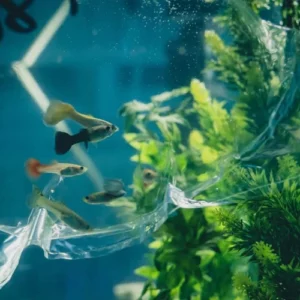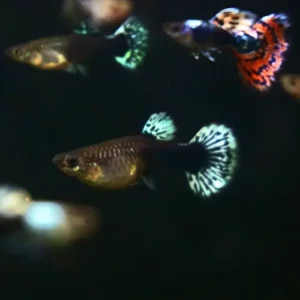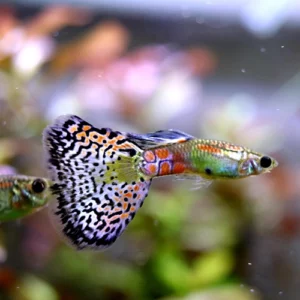Guppy Lifespan: How Long Do Guppies Live
In a controlled and well-maintained aquarium environment, guppies can live up to 2 to 3 years or sometimes even longer. However, in the wild, the lifespan of Guppies typically ranges from 1 to 1.5 years due to natural predators and environmental challenges.
Home » Guides » Fish Care » Guppy » Guppy Lifespan: How Long Do Guppies Live
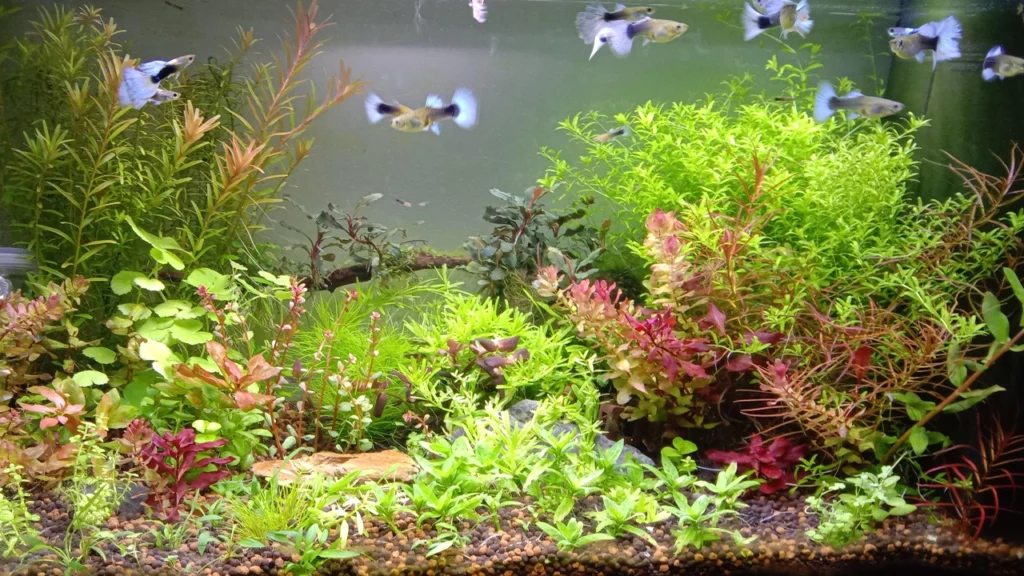
Guppy Care Fact Sheet
| Scientific Name | Poecilia Reticulata |
| Common Name | Guppy, Million Fish |
| Care Difficulty | Easy |
| Life Expectancy | 2+ Years |
| Average Size | 2 Inches (5cm) |
| Temperature | 72°F(22°C) – 82°F(28°C) |
| Diet | Omnivore |
| Behaviour | Friendly/Peaceful |
| Breeding | Easy |
| pH | 6.5-7.5 |
| Live Plant Friendly | Yes |
Natural vs. Captive Lifespan
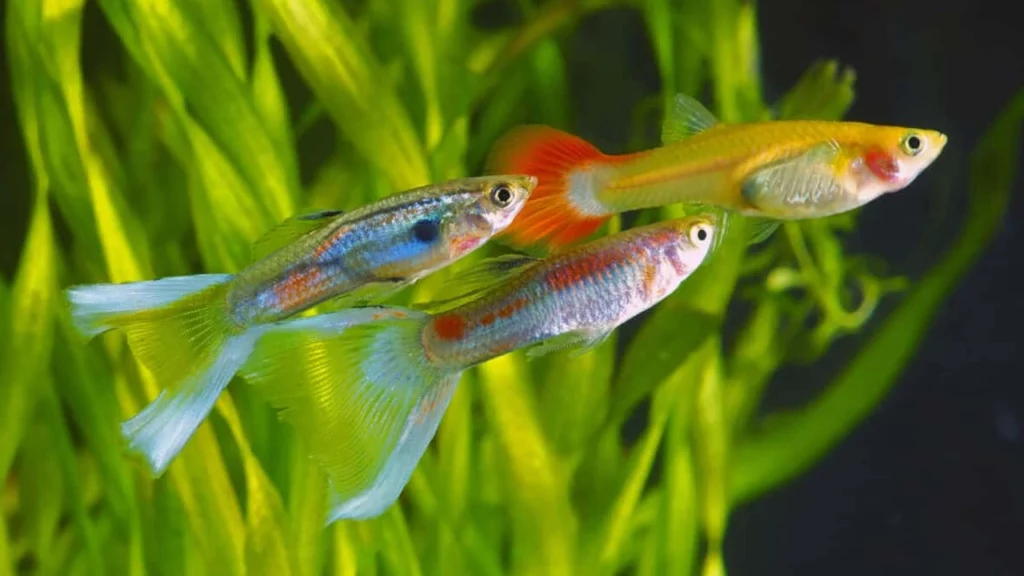
Natural Lifespan of Guppies
In the wild, guppies are found mainly in freshwater bodies in parts of South America, particularly Trinidad and Tobago, Venezuela, and Barbados. Their natural environment is often subject to the whims of Mother Nature.
- Natural Predators: In their natural habitats, guppies are a tasty treat for many predators. Larger fish, amphibians, and even certain insects find them appetizing. The ever-present danger of being hunted shortens the lifespan of many guppies in the wild.
- Environmental Shifts: Natural bodies of water can undergo significant changes based on the season, rain patterns, and human interference. Flash floods, droughts, or even a small change in the mineral composition of water can greatly affect the lives of guppies.
- Life Expectancy: Given the myriad challenges they face in the wild, guppies often live for about 1 to 1.5 years if they manage to escape their predators.
Captive Lifespan of Guppies
In the controlled environment of an aquarium, guppies experience a very different life, one that is often extended due to the absence of natural predators and the careful attention of their human caretakers.
- Protected Environment: Within the safety of an aquarium, guppies are free from the looming threat of larger predators. This alone can significantly extend their lifespan.
- Consistent Water Conditions: When maintained correctly, an aquarium offers consistent water conditions, devoid of the sudden changes faced in natural waters. Such stability helps in promoting better health and longevity.
- Diet: In captivity, guppies get a regular and often nutritionally balanced diet. Unlike in the wild, where they must constantly search for food, captive guppies are often provided with a mix of flakes, pellets, and occasional live or frozen foods. This consistent nutrition plays a significant role in extending their lifespan.
- Life Expectancy: In a well-maintained aquarium, with all their needs addressed, guppies can live up to 2 to 3 years, sometimes even a bit longer.
We go into great detail on how to care for your Guppies in our complete Guppy Care Guide
Factors Affecting Guppy Lifespan
Genetic Influences
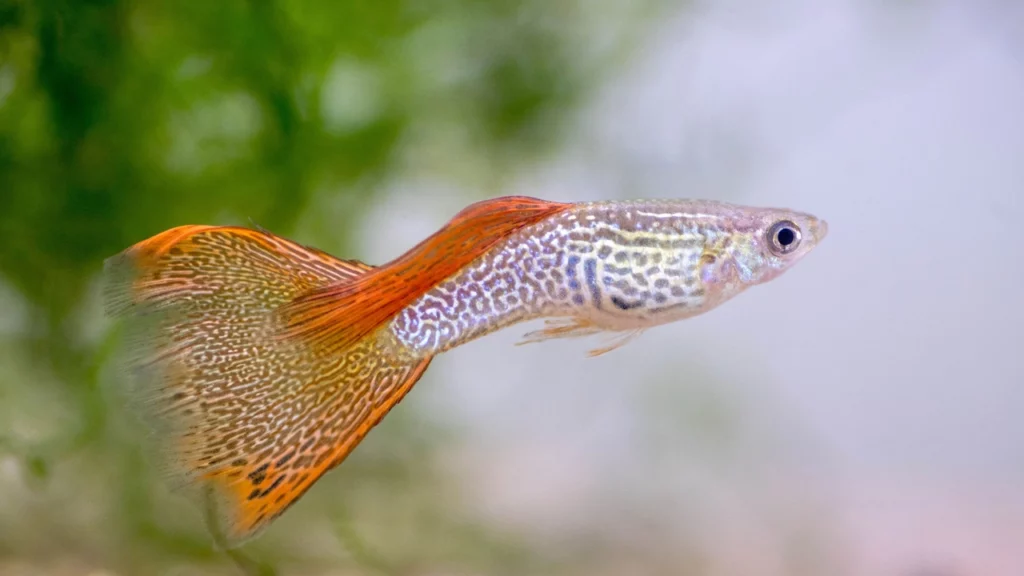
In the intricate ballet of life beneath the water, guppy genetics play a pivotal role. Like a hidden script, these genetics shape the storyline of every guppy’s life.
Role of Breeding
Aesthetics: Throughout aquarium history, we’ve selectively bred guppies to enhance their stunning colors and unique tail patterns. However, as with any art form, focusing solely on the exterior can sometimes cloud our judgment, leading to unintended consequences for the fish’s inner well-being.
Inbreeding: Fancy guppy strains, while visually mesmerizing, occasionally suffer from close-knit breeding. While this can stabilize desired traits, it may also inadvertently weaken their genetic resilience.
Diversity: Progressive breeders recognize that genetic diversity is a treasure. By intermixing varied lines, they cultivate guppies that are not only eye-catching but also robust and hearty.
Hereditary Issues
Shadows of the Past: Genetics carry with them tales from previous generations. At times, these tales may include predispositions to certain ailments or conditions.
Observing & Learning: The health patterns and longevity of parent guppies can offer insights. Recurring health themes across generations may hint at deeper genetic narratives.
The Value of Knowledge: Being informed about the genetic lineage of your guppies is akin to having a roadmap. It can guide care strategies, ensuring that guppies thrive both in spirit and in health.
Water Quality and Conditions
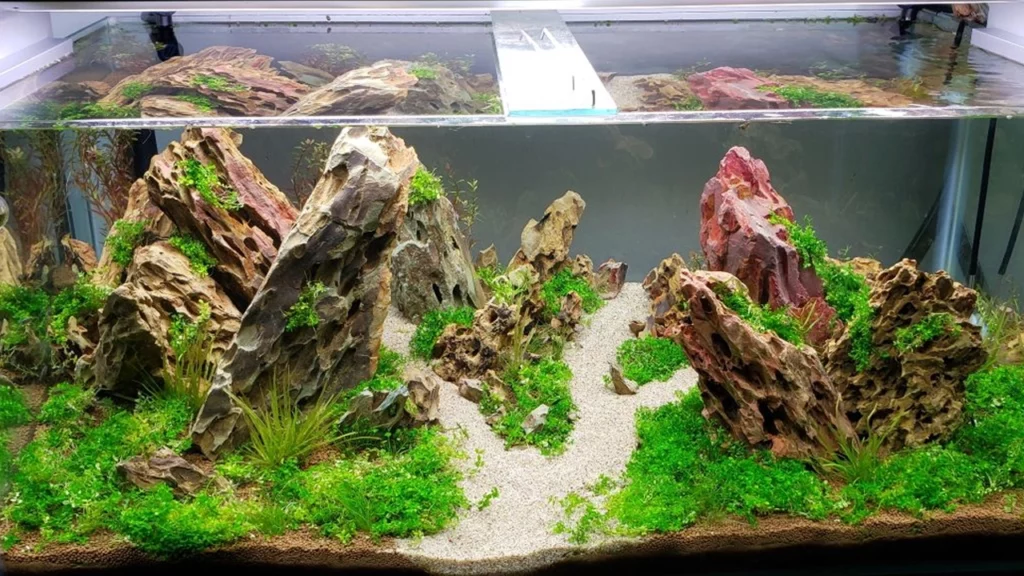
Water, the very essence of life for our guppies, is much more than just H2O. It’s an environment, a home, a playground, and a life force for these tiny creatures. Ensuring that this environment is optimal becomes paramount to their well-being.
Cleanliness and pH Levels
Crystal Clarity: Imagine living in a murky, polluted environment. Sounds unpleasant, doesn’t it? For guppies, clean water is not just a luxury, but a necessity. Regular water changes and adequate filtration ensure that harmful toxins, such as ammonia and nitrites, are kept at bay.
pH – Striking the Balance: Guppies thrive in water with a pH level between 6.8 and 7.8. Any significant deviation from this can stress the fish, making them more susceptible to diseases. Regularly testing the water’s pH and using natural buffers when necessary can keep this balance in check.
Temperature and Water Hardness
Comfort in Warmth: Originating from tropical regions, guppies prefer warmer waters. A consistent temperature range of 74-82°F (23-28°C) is ideal. Using a reliable aquarium heater with a thermostat ensures they’re swimming in comfort.
The Role of Minerals: Guppies thrive in moderately hard water. The presence of minerals like calcium and magnesium not only aids in their overall health but also plays a pivotal role in breeding, ensuring healthy offspring. Testing for water hardness and, if needed, adding appropriate minerals can make a world of difference.
Diet and Nutrition
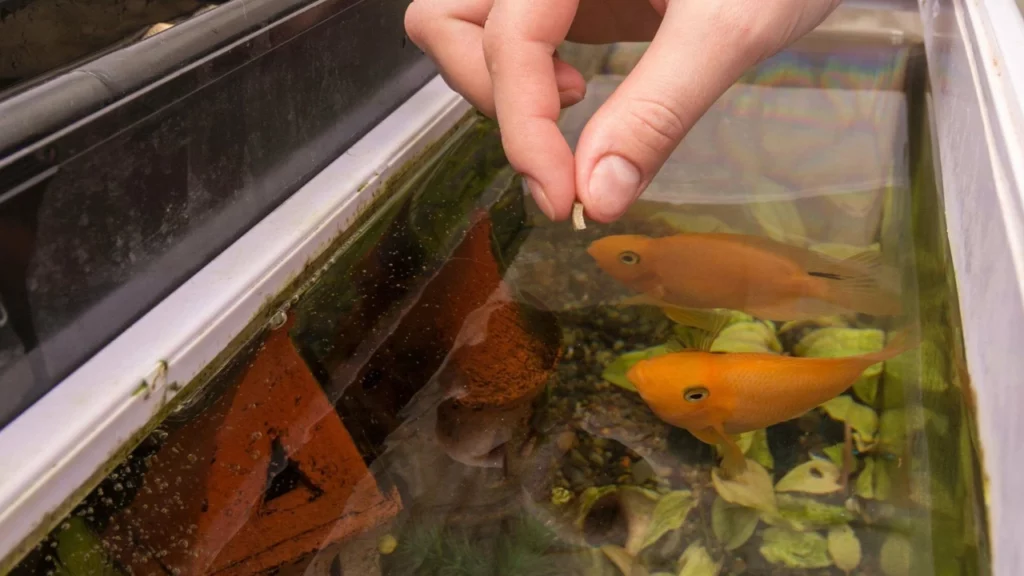
The adage, “You are what you eat,” holds profound truth, even in the aquatic world. For guppies, their diet isn’t just about satiating hunger; it’s the fuel that drives their vibrancy, health, and longevity.
Suitable Foods
Palette of Proteins: Guppies are omnivorous by nature, with a lean towards carnivorous inclinations. High-quality flake foods, enriched with proteins, form an excellent base for their diet. It provides the essential nutrients, ensuring they gleam with health and color.
Occasional Delicacies: While flake foods are nutritious, diversity is key to a well-rounded diet. Introducing live or frozen foods like brine shrimp, daphnia, or bloodworms can be akin to offering a gourmet treat. Not only do these offer proteins and essential fats, but they also stimulate the guppies’ natural hunting instincts.
Plant Matter Matters: Let’s not forget the value of plant-based foods. Spirulina, algae wafers, or even blanched vegetables like zucchini or lettuce can offer additional nutrients and fiber.
Balanced Diet
Avoid Overindulgence: The temptation to keep feeding our guppies, especially when they dart to the surface with eager eyes, can be strong. However, overfeeding can lead to water pollution and health issues. A pinch of food that they can consume within 2-3 minutes, once or twice a day, is a good rule of thumb.
Quality Over Quantity: It’s better to invest in high-quality fish food from reputable brands. These are often more nutritionally dense, ensuring that guppies get the best nourishment from each bite.
Observe and Adapt: Each aquarium and its inhabitants are unique. Observing how your guppies react to various foods, and their health over time, can guide any necessary dietary adjustments.
Predators and Tankmates
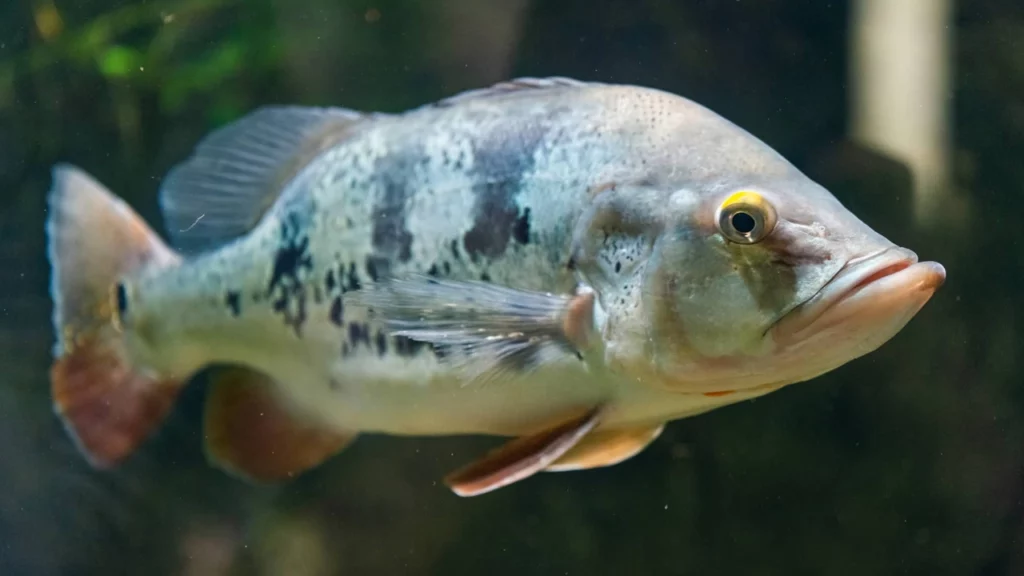
Ah, the delicate balance of community living! Every aquarium is a microcosm of interactions, friendships, and sometimes, rivalries. For guppies, choosing the right neighbors can be the difference between a peaceful coexistence and a constant battle for survival. See our complete guide which has a large table of all Guppy tank mates.
Potential Threats in the Tank
Size Matters: Larger fish, even those with a generally peaceful disposition, might view smaller guppies as a quick snack. Species like angelfish or larger barbs can pose a significant threat to adult guppies, and even more so to their fry.
Aggressive Neighbors: Some fish, by their very nature, are territorial or aggressive. Betta fish, for example, while similar in size, might bully or nip at guppies, especially those with long, flowing tails.
Guarding the Nursery: Guppy fry are tiny and, unfortunately, a tempting treat for many fish, including other adult guppies. If breeding is on the agenda, consider separate breeding tanks or safe zones for the fry.
Choosing Safe Tankmates
Peaceful Companions: Tetras, mollies, and platies are usually great tankmates for guppies. Their peaceful nature and similar size make for harmonious living.
Bottom Dwellers: Corydoras catfish and otocinclus are bottom dwellers that not only get along well with guppies but also play a significant role in keeping the tank clean.
Space and Environment: While choosing tankmates, consider their environmental needs as well. Ensure that the tank isn’t overcrowded and that each species has its preferred space – be it the tank’s bottom, middle, or top.
Disease and Health Concerns
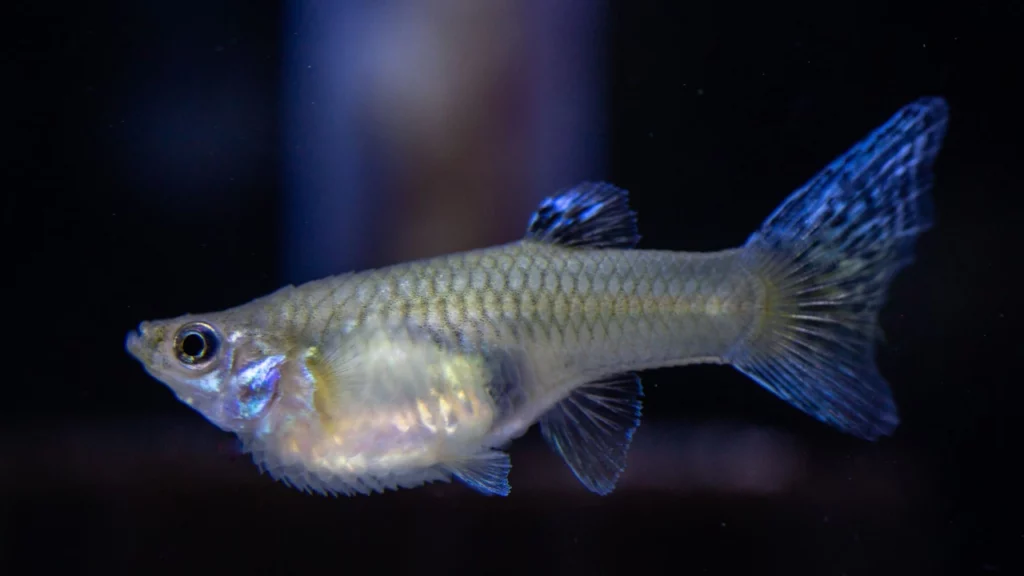
In the mesmerizing dance of aquatic life, health plays the lead role. For guppies, while they can be hearty and resilient, they aren’t immune to the challenges that nature sometimes throws their way. Awareness and proactive care can make all the difference in navigating these waters.
Common Diseases
Ich – The Unwanted Speckles: Often recognized by white, salt-like speckles, Ichthyophthirius multifiliis, commonly known as Ich, is a parasitic disease. Quick action, elevated tank temperatures, and proper medication can treat this ailment.
Fungal Foes: Fuzzy white patches on guppies might indicate a fungal infection. Often occurring in fish that are already stressed or injured, a good antifungal treatment can often clear this up.
Fin Rot: If you notice your guppy’s fins fraying or decaying, it might be battling fin rot. This bacterial infection can stem from poor water conditions or injuries. Early detection, improved water quality, and antibiotics can help in its treatment.
Internal Parasites: Skinny despite regular feeding? Your guppy might be hosting internal parasites. These can be more challenging to diagnose but can often be treated with specialized food or medication.
Treatments and Prevention
Quarantine: Introducing new fish? A two-week quarantine period can ensure they’re disease-free and won’t introduce pathogens to the main tank.
Water Quality: Many ailments stem from subpar water conditions. Regular water changes, proper filtration, and routine tests can act as the first line of defense against diseases.
Nutrition: A balanced diet can bolster a guppy’s immune system, preparing it to ward off potential health threats.
Observation: A keen eye is an aquarist’s best tool. Regular observation can spot unusual behaviors or physical changes, allowing for early intervention.
Tips to Extend the Lifespan of Guppies
Monitoring and Water Changes
Within the confines of an aquarium, life ebbs and flows in a cycle of beauty and balance. Central to this balance is the water quality. Imagine it as the very air we breathe; for guppies, the water embodies that lifeline. Its purity and consistency shape their daily lives.
The Silent Accumulation: Over time, even in the most well-maintained aquariums, waste products, uneaten food, and plant debris accumulate. These can lead to heightened levels of ammonia, nitrites, and nitrates – invisible threats that can jeopardize a guppy’s well-being.
The Role of Water Changes: Incorporating regular water changes – typically 10-25% of the tank volume weekly or bi-weekly – acts as a reset button. It dilutes harmful substances, replenishing the environment with fresh, oxygen-rich water. Think of it as a revitalizing spring rain for the aquatic landscape.
Test, Don’t Guess: Monitoring kits are indispensable. By routinely testing the water parameters, you can gauge the health of the aquatic ecosystem. A spike in ammonia or nitrites can serve as a warning, prompting immediate action.
Temperature and Acclimation: While changing water, ensure the new water is close in temperature to the tank’s current conditions. Rapid temperature shifts can stress guppies. And always remember to treat tap water with a dechlorinator before adding it to the tank.
Proper Feeding Habits
In the mosaic of aquarium care, the art of feeding stands out with its hues of necessity and nuance. Nourishing guppies isn’t just about providing sustenance, but also understanding their unique dietary rhythm.
Frequency and Consistency: Like clockwork, guppies thrive on routine. Feeding them once or twice a day, at the same times, allows them to anticipate and prepare. Such consistency can reduce stress and enhance digestion.
Less is More: It’s a natural instinct – the desire to satiate our pets. However, overfeeding can muddy the waters, both literally and figuratively. Excess food not only fouls the water but can also lead to obesity and health complications. Offer guppies what they can consume within 2-3 minutes. Their stomachs are about the size of their eyes, so small, frequent meals are preferable.
Variety – The Spice of Aquatic Life: While staple flake foods form the cornerstone of a guppy’s diet, periodic inclusions of live, freeze-dried, or frozen foods can provide essential nutrients and break the monotony. This occasional shift can invigorate their palate and promote overall well-being.
Observation is Key: Each guppy, with its personality and preferences, might have different dietary needs. Watch their feeding behaviors. Are they eager? Do they leave food behind? Adjusting portions and types of food based on these observations ensures they get the nutrition they need without excess waste.
Quarantine Procedures
Ah, the age-old wisdom of ‘prevention is better than cure.’ When introducing new aquatic residents to our established communities, it’s a mantra that holds a world of truth. The quarantine process, sometimes overlooked in the excitement of new additions, plays a pivotal role in ensuring the safety and health of all tank inhabitants.
The Why Behind Quarantine: Even if a new fish appears healthy, it might be harboring undetectable pathogens or parasites. Introducing them directly into the main tank can risk the well-being of its current occupants. Quarantine acts as a buffer, a waiting period to observe and ensure that newcomers are in optimal health.
Setting Up a Quarantine Tank: This doesn’t need to be elaborate. A simple setup, separate from the main aquarium, with adequate filtration, heating, and aeration, suffices. The aim is to replicate a stress-free environment for observation, not necessarily to mimic the beauty of the main display.
Duration: Typically, a quarantine period spans 2-4 weeks. This gives ample time to observe the new arrivals for any signs of illness or distress. It’s also an opportunity to treat any issues that might arise before introducing them to the larger community.
Medications and Treatments: Prophylactic treatments, using mild medications, can sometimes be beneficial. However, it’s crucial to understand the specific needs of each species. Blindly medicating can cause more harm than good. Always ensure you’re informed about the particular needs and sensitivities of each fish species.
Gradual Introduction: Once the quarantine period is over and the newcomers are deemed healthy, don’t rush the introduction. Allow them to acclimate to the main tank’s water slowly, gradually mixing the waters until conditions match. This reduces shock and ensures a smoother transition.
Stress-Free Environment
The secret to a thriving aquarium is not just in the technicalities of water parameters or feeding routines but in the ethereal quality of tranquility. Just as we humans cherish moments of serenity, our aquatic friends too find solace in a calm, predictable environment. It’s the unseen magic that rejuvenates and invigorates.
Location: Positioning the aquarium in a quiet spot, away from high foot traffic, loud noises, or sudden movements, ensures that guppies aren’t constantly startled. They prefer locations that mirror the steady rhythm of nature, not the erratic beats of a bustling household.
Lighting: Imagine living under a relentless sun that never sets, or perpetual darkness that never lifts. Lighting in an aquarium should mimic the natural diurnal cycle. Consistent light durations and gradual transitions from dawn to dusk can set the mood right for guppies, preventing undue stress.
Landscaping: Plants, caves, and hiding spots aren’t just decorative additions; they’re havens of comfort. Guppies, especially when they feel vulnerable or just need a moment to themselves, find solace in these nooks and crannies. An environment rich in such retreats is akin to a comforting embrace.
Avoid Overcrowding: Space is not just physical but psychological. Overcrowding can lead to competition for resources, territorial disputes, and heightened stress. By ensuring adequate space for each guppy to move, explore, and rest, we’re granting them the luxury of freedom.
Consistency: Sudden changes, whether in water parameters, temperature, or even the introduction of new tankmates, can be jarring. While changes are sometimes inevitable, ensuring they’re gradual can cushion the impact on our aquatic companions.
Signs of an Aging Guppy
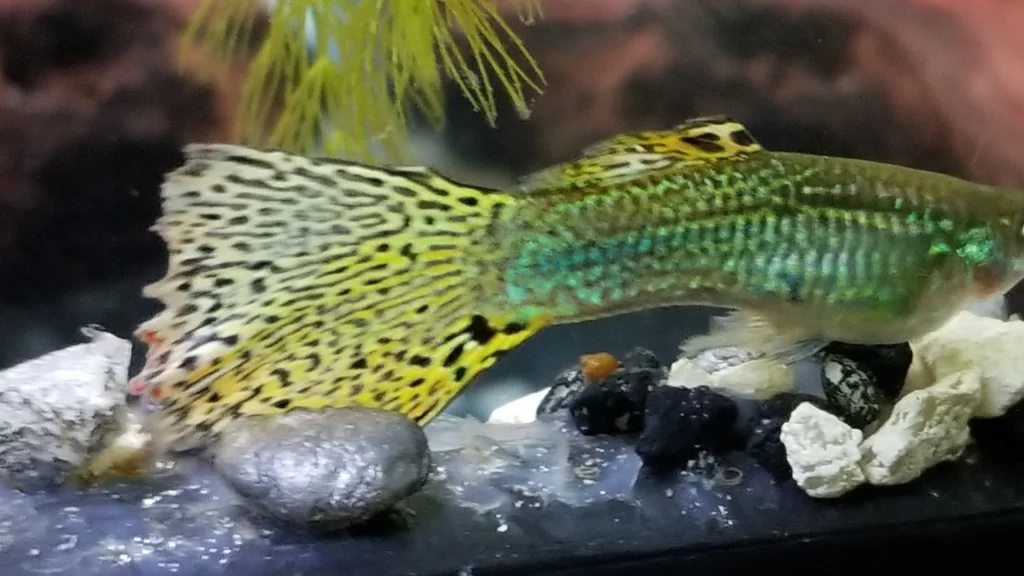
In the fluid waltz of aquatic life, age gracefully touches every fin and scale, painting tales of journeys swum and experiences lived. Recognizing the signs of an aging guppy helps aquarists provide the tender care these seasoned fish deserve, ensuring their twilight years are as comfortable and enriched as their vibrant youth.
Physical Indicators
Color Dimming: One of the first noticeable shifts might be in their vibrant hues. An older guppy’s colors may fade or appear less brilliant, much like the way autumn leaves mellow from their summer vibrancy.
Thinning Body: As metabolism slows and muscle mass might diminish, an older guppy could look leaner, even if its appetite remains consistent.
Frayed or Clamped Fins: Age can wear on the delicate fins of a guppy, causing them to fray or appear more clamped. This isn’t necessarily a disease but a testament to the many waters they’ve navigated.
Slower Movements: Their once swift and darting movements might mellow into a leisurely swim, akin to a seasoned dancer’s graceful glide.
Cataract Development: Just as humans might develop cataracts, guppies too can show cloudiness in their eyes, indicating age or sometimes an underlying health concern.
Behavioral Shifts
Reduced Activity: Older guppies tend to be less active, preferring the tranquility of a favorite spot rather than constantly exploring.
Shift in Feeding Behavior: They might be slower to reach food or show a decreased appetite, a natural progression with a slowing metabolism.
Increased Vulnerability: As their vigor wanes, they might become more susceptible to illnesses or bullying from more energetic tankmates.
Preference for Shelter: Seeking out more secluded or sheltered spots might become common, as they cherish the serenity and safety these places offer.
Frequently Asked Questions – FAQ
Give Us Feedback
Please help us get better by making suggestions or giving feedback, we really do listen to it!
Articles You Might Like
